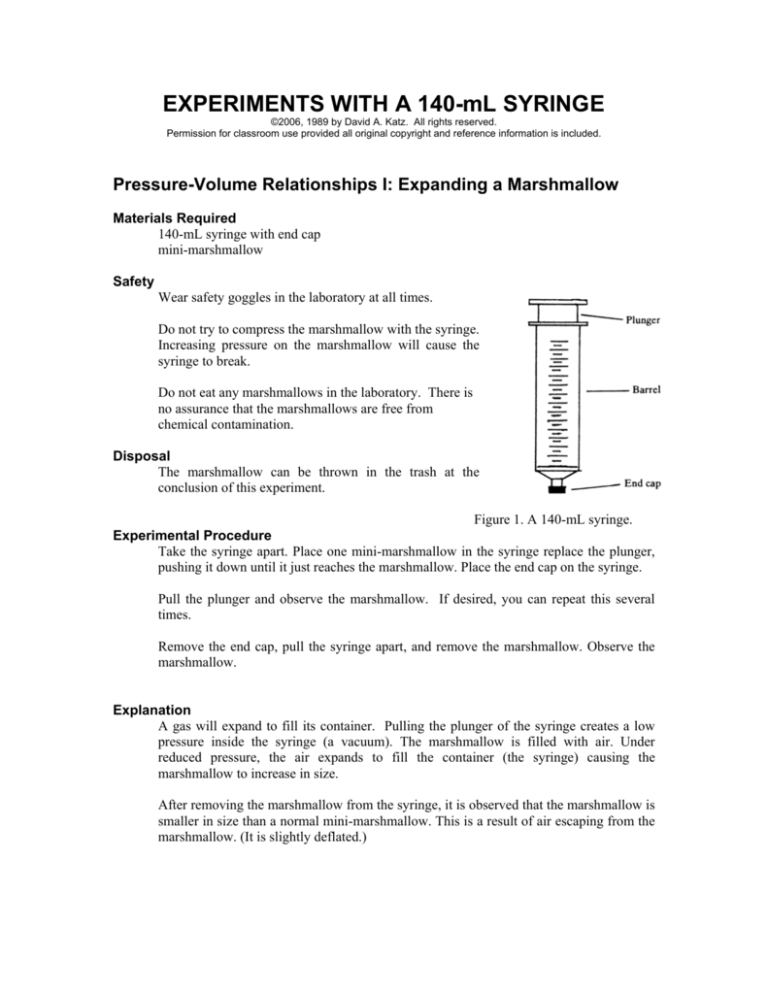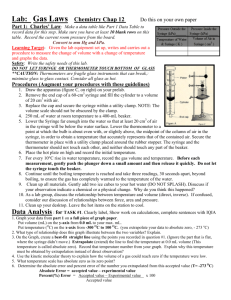
EXPERIMENTS WITH A 140-mL SYRINGE
©2006, 1989 by David A. Katz. All rights reserved.
Permission for classroom use provided all original copyright and reference information is included.
Pressure-Volume Relationships I: Expanding a Marshmallow
Materials Required
140-mL syringe with end cap
mini-marshmallow
Safety
Wear safety goggles in the laboratory at all times.
Do not try to compress the marshmallow with the syringe.
Increasing pressure on the marshmallow will cause the
syringe to break.
Do not eat any marshmallows in the laboratory. There is
no assurance that the marshmallows are free from
chemical contamination.
Disposal
The marshmallow can be thrown in the trash at the
conclusion of this experiment.
Figure 1. A 140-mL syringe.
Experimental Procedure
Take the syringe apart. Place one mini-marshmallow in the syringe replace the plunger,
pushing it down until it just reaches the marshmallow. Place the end cap on the syringe.
Pull the plunger and observe the marshmallow. If desired, you can repeat this several
times.
Remove the end cap, pull the syringe apart, and remove the marshmallow. Observe the
marshmallow.
Explanation
A gas will expand to fill its container. Pulling the plunger of the syringe creates a low
pressure inside the syringe (a vacuum). The marshmallow is filled with air. Under
reduced pressure, the air expands to fill the container (the syringe) causing the
marshmallow to increase in size.
After removing the marshmallow from the syringe, it is observed that the marshmallow is
smaller in size than a normal mini-marshmallow. This is a result of air escaping from the
marshmallow. (It is slightly deflated.)
Pressure-Volume Relationships II: Boyle's Law
Materials Required
140-mL syringe with end cap
Ring stand with clamp or wood block with hole drilled in it or other device to hold
syringe in an upright position.
Weights or books (each should be the same size)
Safety
Wear safety goggles in the laboratory at all times.
The syringe must be well supported to prevent it from
falling over when weights or books are placed on it.
Experimental Procedure
Withdraw the plunger of the syringe to some position,
such as 100-mL. Place the end cap on the syringe and
support the syringe in an upright position (plunger on
top).
Place a weight or book on the top of the plunger. Read
the volume of the air trapped in the syringe and record
it. Repeat this procedure with a second I weight or book.
Repeat with a third, fourth, fifth, etc... book.
Figure 2. Measuring
pressure-volume relationships by
placing a book on an upright
Graph the results using the volume of the gas on the x-axis and the number of books, or
weights, on the y-axis.
Explanation
There is a great deal of open space between the molecules of a gas. When pressure is
applied to a volume of a gas, the molecules are compressed (pushed closer together).
The relationship between the pressure of a gas and its volume is known as Boyle's law. It
states that, at constant temperature, the pressure times the volume is equal to a constant:
PV = k Thus, if the pressure on a gas is increased, its volume is decreased and if the
pressure on the gas is decreased, its volume increases.
Pressure-Volume Relationships III: Boiling Water
Materials Required
140-mL syringe with end cap
water (room temperature or warm)
Safety
There are no safety hazards with this procedure.
Experimental Procedure
Draw 20-mL of room temperature or warm water into the syringe. Expel all the air from
the syringe. Place the end cap on the syringe.
Pull the plunger and observe the water. What do you observe? Has the temperature of
the syringe changed?
Explanation
Boiling of a liquid occurs when the vapor pressure of the liquid (the tendency of the
liquid molecules to change state to a gas) is equal to the atmospheric pressure. Vapor
pressure, and the boiling point, are related to the size of the liquid molecules, the mass of
the liquid molecules, and the forces of attraction between them. The vapor pressure of a
liquid increases as the temperature of the liquid increases until the liquid reaches its
boiling point.
Vaporization of a liquid can be demonstrated by pouring a small amount of liquid onto a
cotton ball or a small piece of sponge and wiping it on a clean, dry chalkboard. To
compare the rates of vaporization (differences in vapor pressure) of several liquids, have
several students wipe small amounts of liquid on a chalkboard simultaneously. Some
liquids that can be used are acetone (nail polish remover – non-oily type), ethyl rubbing
alcohol, isopropyl rubbing alcohol, dry cleaning fluid (naphtha), and water. Safety Note:
Provide adequate room ventilation for this demonstration.
If the atmospheric pressure above a liquid is reduced, then the liquid can boil at a lower
temperature. Less heat, or in many cases, no additional heat will be required to boil the
liquid.
Measuring the Mass of a Gas
Materials Required
140-mL syringe with end cap
nail
gases: natural gas, butane (from a cigarette lighter), carbon dioxide (from dry ice or
vinegar and baking soda), oxygen or nitrogen from compressed gas cylinders, etc...
plastic bag (with twist tie or Zip-Loc type)
balance (centigram or milligram capacity)
electric drill with drill bits (to prepare syringe)
Safety
Wear safety goggles at all times in the laboratory
Some of the gases used may be flammable. Avoid all
flames.
Work with adequate ventilation
Experimental Procedure
To prepare the syringe
Withdraw the plunger of the syringe to some preset
volume such as 100 mL or 140-mL. Mark the
plunger, even with the top of the syringe barrel,
and drill a hole through the plunger handle large
enough to accommodate a metal nail. With the nail
inserted in the hole, the plunger cannot be pushed
into the syringe barrel but it can still be withdrawn.
Weighing an empty syringe
Assemble the syringe. Push the plunger all the way
into the syringe. place the end cap on the syringe.
Pull the plunger out to a preset volume and have
someone place a nail through the hole in the
plunger. Weigh the syringe. This is the mass of the
empty syringe.
Figure 3. A 140-mL syringe
with a nail through the
plunger for measuring the
mass of a gas.
Weighing a gas
Fill a plastic bag with a gas (or use air). Put the syringe tip through the plastic
bag and fill it with the gas. Remove the syringe and exhaust the gas. (This flushes
the syringe) Insert the syringe back into the plastic bag and fill the syringe to the
preset volume. Insert the nail and push the syringe to the "closed' position. Weigh
the syringe and gas. Subtract the mass of the empty syringe to get the mass of the
gas.
The density of the gas can be calculated by dividing the mass of the gas by the preset volume
used in the syringe. Correct the density for standard temperature and pressure.
Calculate the molar mass of the gas.








